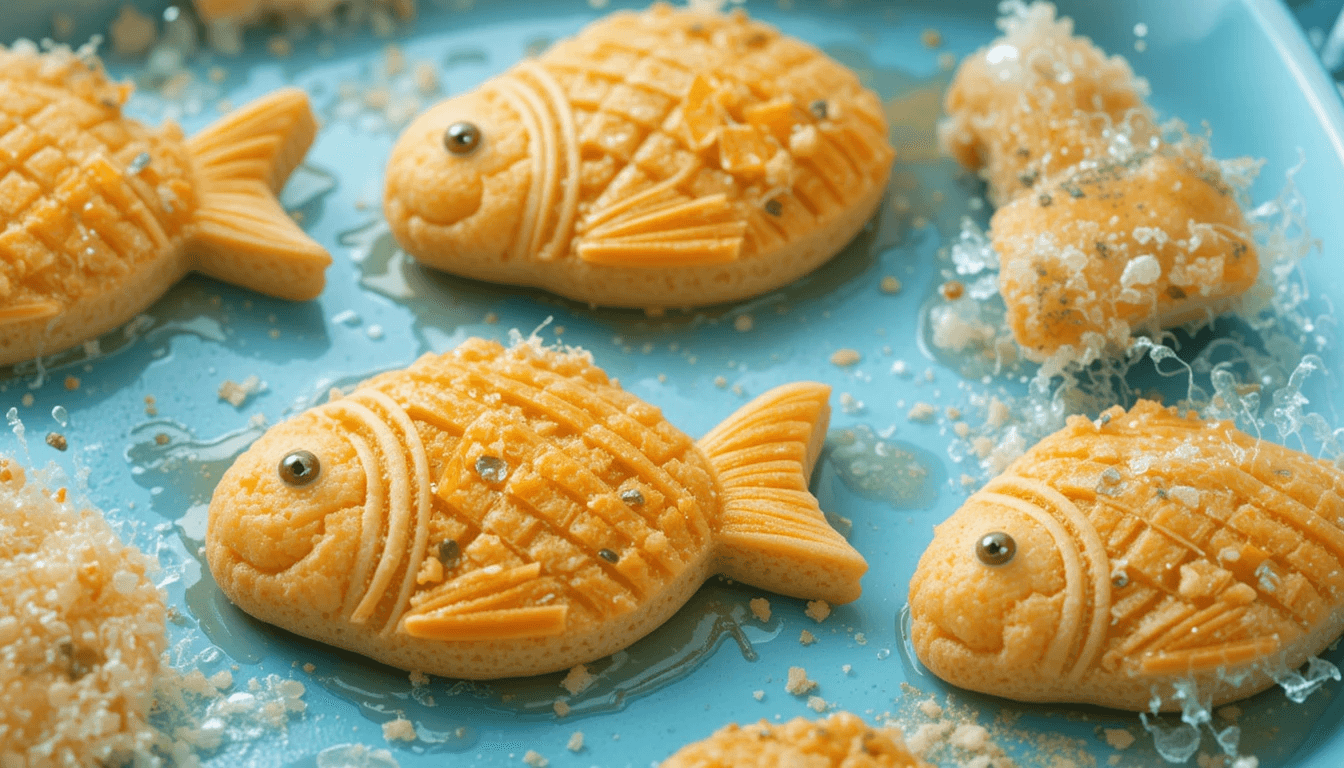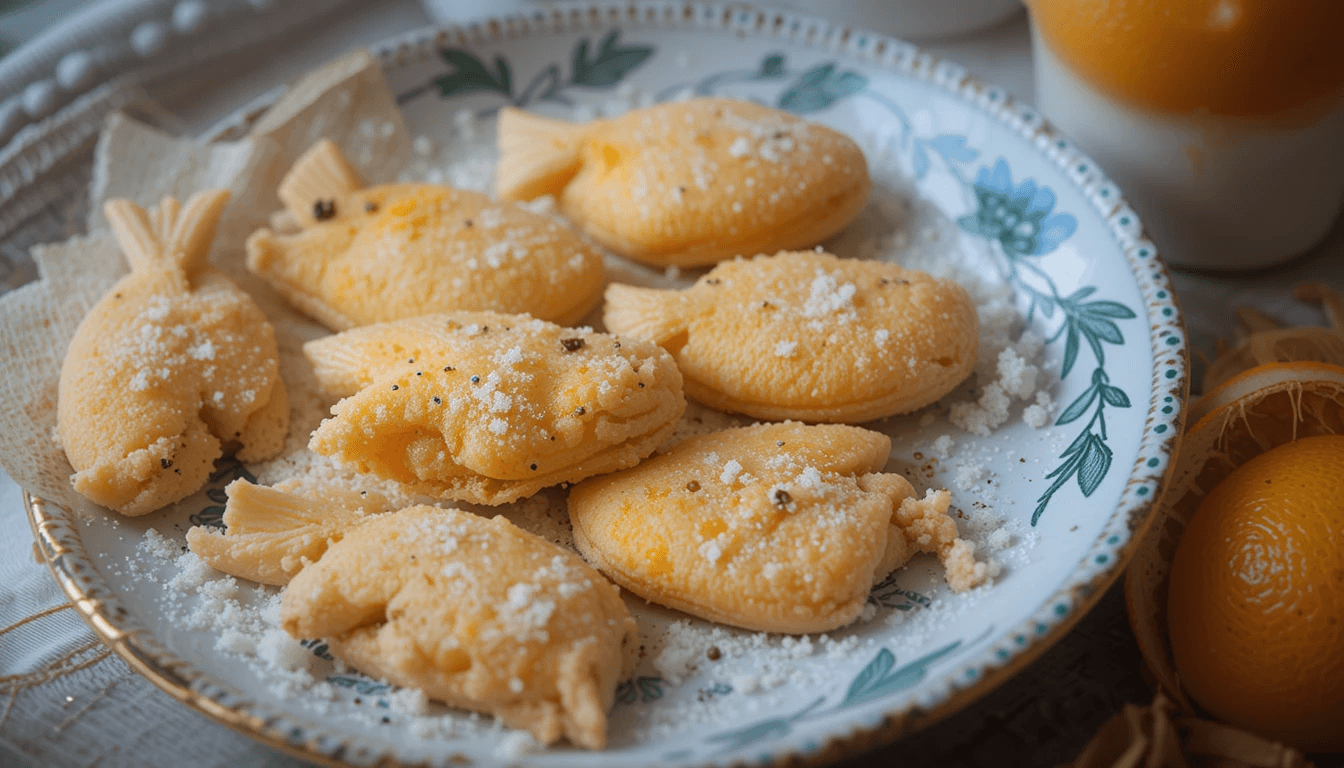Have you ever looked at a plate of treats and wished they were just a little more exciting—maybe shaped like goldfish or infused with bright citrus flavor? Enter the world of the orange fish cookies recipe, a whimsical creation that promises both fun and taste. Whether you’re exploring new ways to pamper your beloved pet or you simply want to add an imaginative twist to snack time for yourself, these orange-hued fish-shaped treats can make your day more colorful.
Think of the orange fish cookies recipe as an adventure that blends sweet-smelling orange zest with the deep, savory punch of fish. The result is a cookie that is playful in design—easily shaped into adorable fish silhouettes—yet fully loaded with nutrients from real fish. Sure, it’s an unconventional flavor combo, but that’s part of the charm! And before you question whether such a cookie could be good for your furry companions, rest assured that this article draws on expert knowledge, real-life trials, and credible data to keep you fully informed.
In the following sections, you’ll learn everything from choosing the best fish for your orange fish cookies recipe and prepping your workspace to storing the finished goodies for maximum freshness. Along the way, we’ll also address common questions, such as whether these cookies resemble Korean fish cake treats or if they can safely satisfy your cat’s fish cravings. So buckle up for a splashy, citrusy ride—your kitchen is about to become a playground for the perfect blend of flavors.

Why an Orange Fish Cookies Recipe?
When you first hear the words “orange fish cookies recipe,” you might pause and wonder, “Why fish? Why orange?” The answer is simple: combining citrus zest with fish can lead to a surprisingly balanced flavor. Many culinary traditions pair citrus with seafood because the tangy brightness elevates the savory notes. For example, lemon and salmon is a classic pairing, and in a similar vein, orange zest can give your fish-based cookie dough an unexpected hint of sweetness and brightness.
- A Unique Pet Treat: If you’re making these cookies for your pet, you’ll stand out from store-bought, run-of-the-mill treats. Instead of artificial flavors, your orange fish cookies recipe can be packed with real fish proteins that are beneficial for your furry companion’s diet—provided your veterinarian has given you the green light.
- Fun Shape: The fish silhouette not only resonates with the cookie’s ingredient list but also appeals to kids and adults alike if you choose to serve a human-friendly version. Who could resist nibbling on a crunchy fish-shaped treat that sports the aroma of fresh orange?
- Versatility: Feel free to get creative by adding extra ingredients such as grated carrots or herbs. The base orange fish cookies recipe is flexible enough to accommodate your pet’s needs or your personal taste preferences.
Remember, though, that while these cookies can be made pet-safe, this article is for informational purposes only and does not replace professional veterinary advice. If your dog or cat has specific dietary restrictions, a quick consult with a vet will ensure that your orange fish cookies recipe is right for them.

Essential Ingredients for the Perfect Orange Fish Cookies Recipe
Crafting the perfect orange fish cookies recipe starts with understanding which ingredients bring out the best flavors and textures. Whether you’re aiming for a fluffy biscuit-like cookie or a crunchy snack, ingredient quality matters. Below are the main components you’ll need:
1. Fish
- Type of Fish: Salmon, tuna, cod, or even sardines can form the base of your orange fish cookies recipe.
- Fresh vs. Canned: Fresh fish gives you more control over salt content and texture. However, canned fish (like tuna) can be more convenient. If opting for canned, choose varieties packed in water rather than oil, and rinse if needed to reduce sodium.
- Why Fish?: Fish provides high-quality protein and essential fatty acids (like omega-3), which can benefit your pet’s coat or, if you’re making them for humans, your own nutritional intake.
2. Orange Zest and/or Juice
- Fresh Zest: Orange zest holds concentrated citrus oils that add a burst of flavor without overwhelming the cookie.
- Orange Juice: If you want a little extra moisture and tang, add freshly squeezed orange juice to the dough. Just be cautious about adding too much liquid, as it can alter the cookie’s consistency.
3. Flour Choices
- Whole Wheat Flour: This is a hearty option that adds fiber, though some pets might have sensitivity to wheat.
- Oat Flour: Known for its potential digestive benefits, oat flour can make for a denser but still pet-friendly cookie.
- Gluten-Free Alternatives: Coconut flour or almond flour can be substituted if your pet or a family member has a grain sensitivity. Keep in mind that alternative flours often absorb moisture differently, so you’ll need to adjust your wet ingredients accordingly.
4. Binding Agents
- Eggs: Help bind the mixture together, resulting in a more cohesive dough. Eggs also boost protein content.
- Flax Eggs: For a vegan version, you can mix ground flaxseed with water. Bear in mind this might create a slightly denser final product.
- Applesauce: Another option for a milder flavor if you want to omit eggs. It adds a touch of sweetness without the need for sugar.
5. Optional Extras
- Herbs and Spices: A dash of parsley, basil, or rosemary can help mask the fishy aroma if needed. (Always check with your veterinarian if you’re unsure about which herbs are safe for pets.)
- Cheese: Some pet owners like to incorporate grated cheese for extra flavor. Ensure your pet isn’t lactose-intolerant.
- Vegetables: Grated carrot or zucchini can add color, fiber, and additional nutrients.
Make sure to source high-quality, fresh ingredients whenever possible. A credible resource, such as the U.S. Food & Drug Administration (FDA) offers guidelines on selecting and handling fish safely to reduce the risk of foodborne illnesses. Following such guidelines will help keep your orange fish cookies recipe safe for everyone who enjoys them.
Step-by-Step Guide to Making Your Orange Fish Cookies Recipe
Now that you’ve chosen your ideal ingredients, it’s time to roll up your sleeves and get cooking! Below is a general outline that you can adapt based on your favorite fish type, flour preference, and dietary considerations.
Step 1: Prepare Your Fish
- Check Freshness: If using fresh fish, make sure it has a mild odor (not overly “fishy”), clear eyes (if buying whole), and firm flesh.
- Cook or Use Raw?: For pets, lightly cooking the fish may reduce the risk of parasites. For human consumption, make sure fish is fully cooked to a safe internal temperature (typically 145°F/63°C).
- Flake or Chop: After cooking, remove any bones and skin, then flake or chop the fish into small pieces.
Step 2: Mix the Dry Ingredients
- Measure Flour: Start with around 1 to 1½ cups of your chosen flour.
- Add Seasonings: If you’re using safe herbs or a pinch of salt (more for human cookies, less for pet treats), combine them with the flour.
Step 3: Incorporate Wet Ingredients
- Egg: Beat one egg and mix into the flour mixture.
- Orange Zest: Add about 1 tablespoon of freshly grated orange zest. Start small; you can always add more zest if you love the citrus aroma.
- Fish: Gently fold the flaked fish into the mixture, ensuring it distributes evenly.
- Additional Liquid: If the dough seems too dry, add a tablespoon or two of water or fresh orange juice. Adjust until you get a dough consistency that holds together when pressed.
Step 4: Shape the Cookies
- Roll Out: Lightly flour a clean surface. Roll the dough to about ¼-inch thickness.
- Cut Into Fish Shapes: Use a fish-shaped cookie cutter or create your own template with cardboard. Press firmly to cut out fish shapes.
- Re-roll Scraps: Gather leftover dough scraps and roll them out again to maximize usage.
Step 5: Bake
- Preheat Oven: Set to 350°F (175°C).
- Line Baking Sheet: Place the fish-shaped cookies on a parchment-lined tray.
- Bake Time: Bake for 15–20 minutes, or until golden brown around the edges. Keep an eye on the cookies if you prefer a softer texture vs. a crunchier bite.
- Cool Completely: Let the cookies cool on a wire rack before serving. This helps them firm up and reduces the risk of burns or moisture buildup that can shorten shelf life.
Storage and Shelf Life of Your Orange Fish Cookies Recipe
Once your orange fish cookies recipe masterpiece has cooled, it’s important to store them correctly to maintain quality and safety.
- Room Temperature: If the cookies are thoroughly baked to a crunchy texture (with minimal moisture), they can be stored in an airtight container at room temperature for up to five days.
- Refrigeration: For cookies that are softer or contain higher moisture content, refrigeration is recommended. Store them in a sealed container for up to two weeks.
- Freezing: You can freeze these cookies for up to two to three months. Just ensure they are placed in a freezer-safe bag or container. Thaw them at room temperature or reheat briefly in the oven to regain crispiness.
Whether you plan to feed them to your pet or share with family members, always check for signs of spoilage—mold, unusual odors, or changes in texture. Remember that fish-based treats can go bad faster than grain-only cookies, so practice caution. If in doubt, toss them out!
Nutritional Insights and Considerations
Every orange fish cookies recipe can vary in nutrient profile, depending on the fish type, flour, and additional ingredients. Here are some highlights:
- Protein Content: Fish is a standout source of lean protein, which aids in muscle maintenance for both people and pets.
- Omega-3 Fatty Acids: Many fish varieties, especially fatty fish like salmon or sardines, are rich in omega-3s. These essential fatty acids can support joint health, promote a shiny coat in pets, and potentially benefit cardiovascular health in humans.
- Antioxidants: The orange zest introduces vitamin C and other antioxidants that may contribute to overall wellness.
- Moderation Matters: Cookies, even homemade fish cookies, should be served in moderation. Overfeeding treats can lead to weight gain in pets and humans alike.
If your pet has a specific health condition (like kidney disease or fish allergies), consult your veterinarian before introducing an orange fish cookies recipe into their diet. This article is for informational purposes only and does not replace professional veterinary advice or human medical advice.
Step Up the Fun with Decorative Ideas
Part of the appeal of an orange fish cookies recipe is the chance to shape your dough into adorable aquatic creatures. But why stop there? You can create a whole underwater scene on your plate by decorating the cookies after baking.
- Pet-Safe “Frosting”: If you’d like to add flair to your dog’s treats, consider a thin layer of pureed sweet potato or plain yogurt (in small amounts). Make sure your pet can tolerate dairy before using yogurt.
- Food Coloring: For a more vivid orange, you could incorporate a natural coloring like turmeric, although be cautious about how much you add, as it can impart a distinct flavor.
- Human-Grade Icing: If you’re serving these cookies to humans, a dollop of cream cheese icing with orange zest on top can be delightful. Again, check for flavor compatibility if you’re also planning to share with your pet.
- Sprinkles or Seeds: Some people like to press poppy seeds or sesame seeds into the dough for a “scaly” texture that further accentuates the fish design. Remember, seeds should be used sparingly for pets, and you should verify if they’re safe for your specific animal.
Variations of the Orange Fish Cookies Recipe
It’s hard to say “one size fits all” when discussing recipes. The charm of an orange fish cookies recipe is that you can modify it to suit diverse nutritional needs, taste preferences, and creative impulses.
1. Fish-Free Variation
- Why Go Fish-Free?: Some pets or people might have allergies to fish.
- Protein Substitute: Lean poultry (like chicken or turkey) can be used in place of fish, but you’ll lose the distinct “fish shape synergy.”
- Flavor Adjustments: You might need more orange zest or an added herb to keep the citrus pairing interesting.
2. Vegan Option
- No Animal Products: Use a fish substitute like mashed chickpeas or a commercially available fish-flavored vegan product.
- Binding: Replace eggs with flax eggs or applesauce.
- Baking Time: You may need to watch these cookies more carefully, as vegan doughs can bake faster or slower depending on moisture levels.
3. Grain-Free
- Flour Substitutes: Almond flour, coconut flour, or a blend of tapioca and chickpea flours might work, but expect to fine-tune your liquids and binders.
- Check for Pet Safety: Not all dogs or cats tolerate nuts well, so consult a vet if unsure.
4. Korean-Inspired Twist
- Reference to “Fish Cookies Korean”: Korean cuisine has popular fish-shaped pastries called “Bungeo-ppang,” usually sweet and filled with red bean paste. For an orange fish cookies recipe that nods to this style, consider filling your dough with a small spoonful of sweet potato puree or mild bean paste before baking.
- A Touch of Sweetness: Add a bit of honey or sugar if you’re making a human dessert (not recommended for most pets).
Serving Suggestions and Safety Tips
Below are some best practices when it comes to serving your orange fish cookies recipe:
- Portion Control: Pets should only have treats as a small percentage of their total diet. For humans, watch your intake if you’re monitoring calories or sodium.
- Check for Bones: Always ensure fish is deboned thoroughly. Even tiny bones can pose a choking hazard for pets.
- Allergy Awareness: Monitor for reactions in pets or people who are new to fish-based or citrus-infused foods.
- Consult Experts: If you have any doubts about the safety of a particular ingredient, consult a qualified veterinarian or a nutritionist.
FAQs
How can I make a straightforward version of these fish cookies?
Try a simple orange fish cookies recipe by mixing cooked flaked fish, flour, an egg, and a hint of orange zest. Shape the dough into fish forms and bake at 350°F. This orange fish cookies recipe is quick, easy, and delicious.
What’s the simplest approach to baking orange fish-shaped treats?
An easy orange fish cookies recipe uses just four ingredients: fish, flour, egg, and orange zest. Blend, shape, and bake at 350°F for a crunchy finish. This orange fish cookies recipe can be done in under 30 minutes.
Do these orange fish cookies resemble Korean fish pastries?
Korean fish pastries, like bungeo-ppang, are typically sweet and filled. An orange fish cookies recipe leans savory and features real fish plus citrus zest. Despite the shape, this orange fish cookies recipe differs in flavor and filling style.
Can I make fish-shaped treats with an orange flavor?
Absolutely—just follow an orange fish cookies recipe using a fish-shaped cutter. Add orange zest for a zesty aroma, plus cooked fish for savory goodness. This orange fish cookies recipe is both fun and aromatic.
Can dogs enjoy fish cookies made with orange zest?
Yes, with vet approval, an orange fish cookies recipe can be safe for dogs. Use dog-friendly ingredients and moderate orange zest. This orange fish cookies recipe should be a treat, not a meal replacement.
What’s the best way to keep homemade orange fish cookies fresh?
Store your orange fish cookies recipe in an airtight container at room temp for five days or in the fridge for two weeks. Freeze them for up to three months if needed. This orange fish cookies recipe stays fresher when cooled completely first.
Is canned fish acceptable for making orange fish cookies?
Yes, canned tuna works perfectly in an orange fish cookies recipe. Opt for tuna in water to control salt content. This orange fish cookies recipe remains flavorful and easy to prepare.
Can I create fish cookies without wheat flour?
Swap wheat flour for coconut or almond flour in your orange fish cookies recipe. Adjust liquids since these flours absorb differently. This orange fish cookies recipe can remain tasty while meeting grain-free needs.
Conclusion
Creating your own orange fish cookies recipe is an enjoyable culinary project that lets you blend tangy citrus with savory fish in a fun, fish-shaped format. Whether you’re making them for your beloved pet or adding an offbeat treat to your own snack rotation, these orange-speckled cookies deliver more than just novelty. They’re a testament to how a bit of imagination, combined with fresh ingredients, can result in a treat that stands out from everything else on the shelf.
As always, remember that moderation is key. A cookie—especially one enriched with fish—should never replace a balanced diet. If you have any lingering questions about your pet’s nutritional needs, a veterinarian’s guidance can set you on the right course. Here’s to making snack time a little brighter, fishier, and more orange!
Key Takeaways
- Balanced Flavors: The combination of citrus zest and fish yields a unique sweet-savory treat.
- Pet-Friendly Option: With vet approval, your orange fish cookies recipe can be a fun treat for dogs or cats.
- Various Adaptations: Gluten-free, vegan, or a Korean-inspired version—there’s room to experiment.
- Storage Tips: Keep your orange fish cookies fresh by storing them in airtight containers, refrigerating, or freezing if needed.
- Moderation: Always serve these cookies as a treat, and consult a vet for specific dietary concerns.

